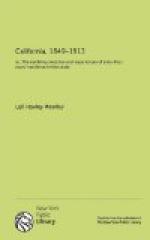We remained for several days to let our animals recruit, as well as ourselves, then we went back and got the wagons. We traveled westward through Carson Valley until we entered the Six Mile Canon, the roughest piece of road that we found between Missouri and California. There were great boulders from the size of a barrel to that of a stage coach, promiscuously piled in the bed of this tributary to the Carson, and over which we were obliged to haul our wagons. It took us two days to make the six miles.
Arrival In California.
Now we see Silver Lake, at the base of the Sierra Nevadas on the east side; our advance to the summit was not as difficult as we anticipated. Having arrived at this point we are at the source of the south fork of the American River and at the summit of the Sierra Nevadas. We now commenced the descent on a tributary of this river.
After a day or two of travel we arrived at a place called Weaverville, on the tenth day of September, 1849. This place consisted of one log cabin with numerous tents on either side. Here was my first mining, but being weary and worn out, I was unable to wield the pick and shovel, and so I left in a few days for Sacramento where I undertook to make a little money by painting, but it was a failure, both as to workmanship and as to financial gain. However, by this time I had gained some strength and left for Beal’s Bar at the junction of the north and south forks of the American River. Here I mined through the winter with some success.
In the spring of 1850 thirty of us formed a company for the purpose of turning the south fork through a canal into the north fork, thereby draining about a thousand yards of the river bed. Just as we had completed the dam and turned the water into the canal, the river rose and away went our dam and our summer’s work with it.
Winter coming on now nothing could be done until spring, so I left for San Francisco where I had heard of the death of a friend at Burns’ old diggings on the Merced River, about seventy-five miles from Stockton, and knowing that his life was insured in favor of his wife I went there and secured the necessary proof of his death so that his widow got the insurance. There was considerable hardship in this little trip of about one week. On my return, and when within about thirty miles of Stockton, I camped for the night at Knight’s Ferry, picketed my pony out, obtained the privilege of spreading my blankets on the ground in a tent and was soon in a sound sleep, out of which I was awakened at about two o’clock in the morning by feeling things considerably damp around me (for it had been raining). I put out my hand and found I was lying in about three inches of water. I was not long getting out of it, rolled up my blankets, saddled my pony and left for Stockton. Here I arrived at about nine o’clock, sold the pony, and was ready to leave at four o’clock for San Francisco. While waiting here (Stockton) I became acquainted with a Kentucky hunter who told me the story of his experiences of the day previous. He said:




